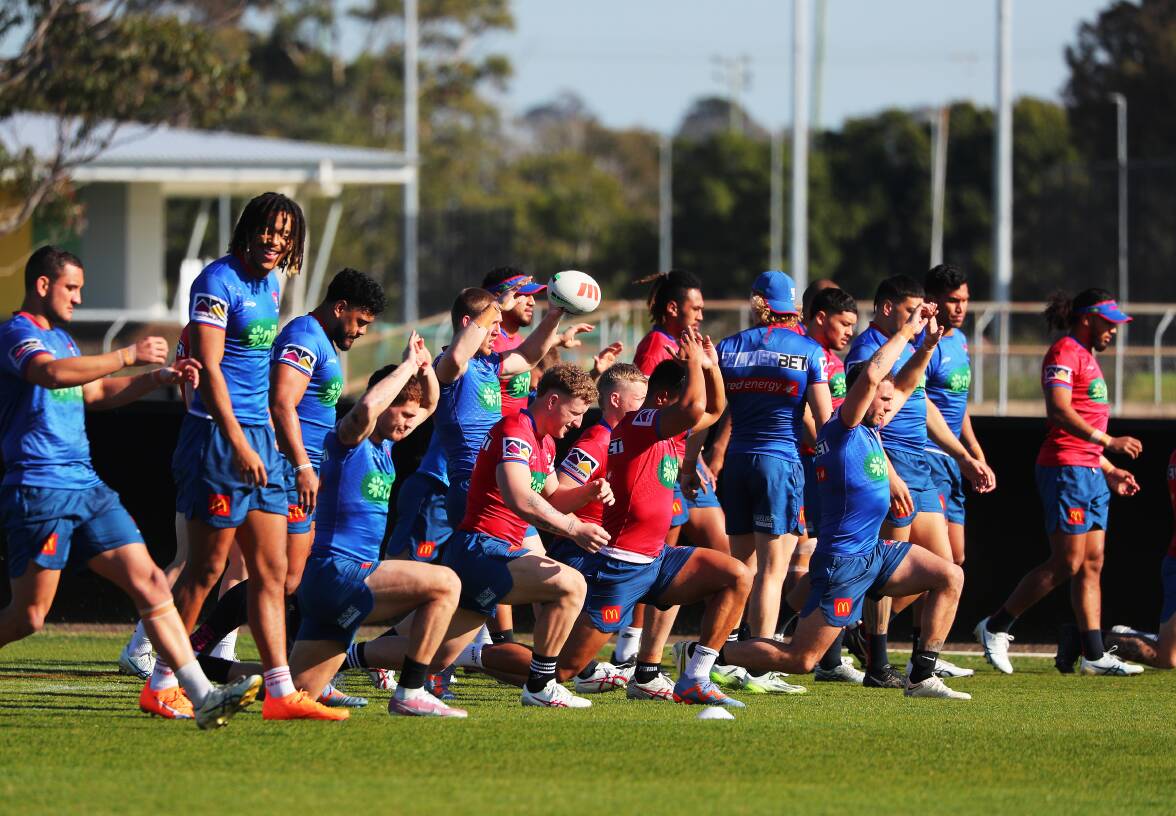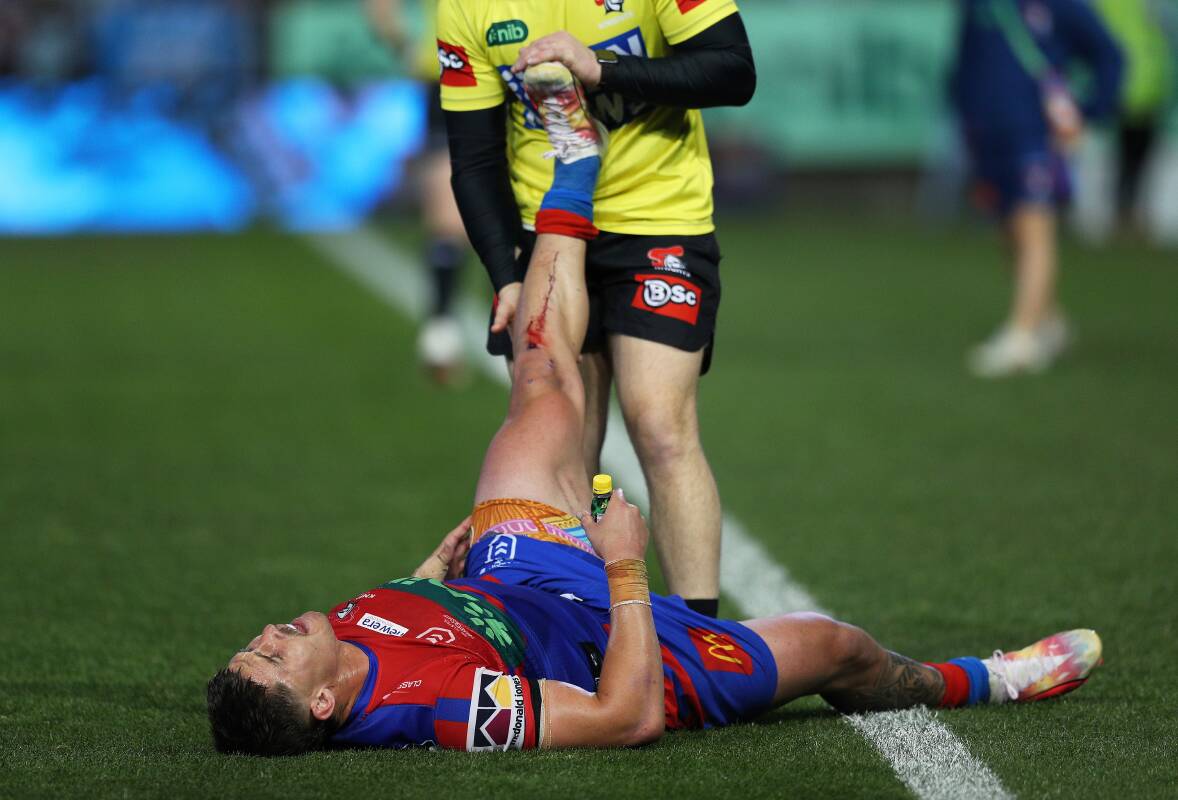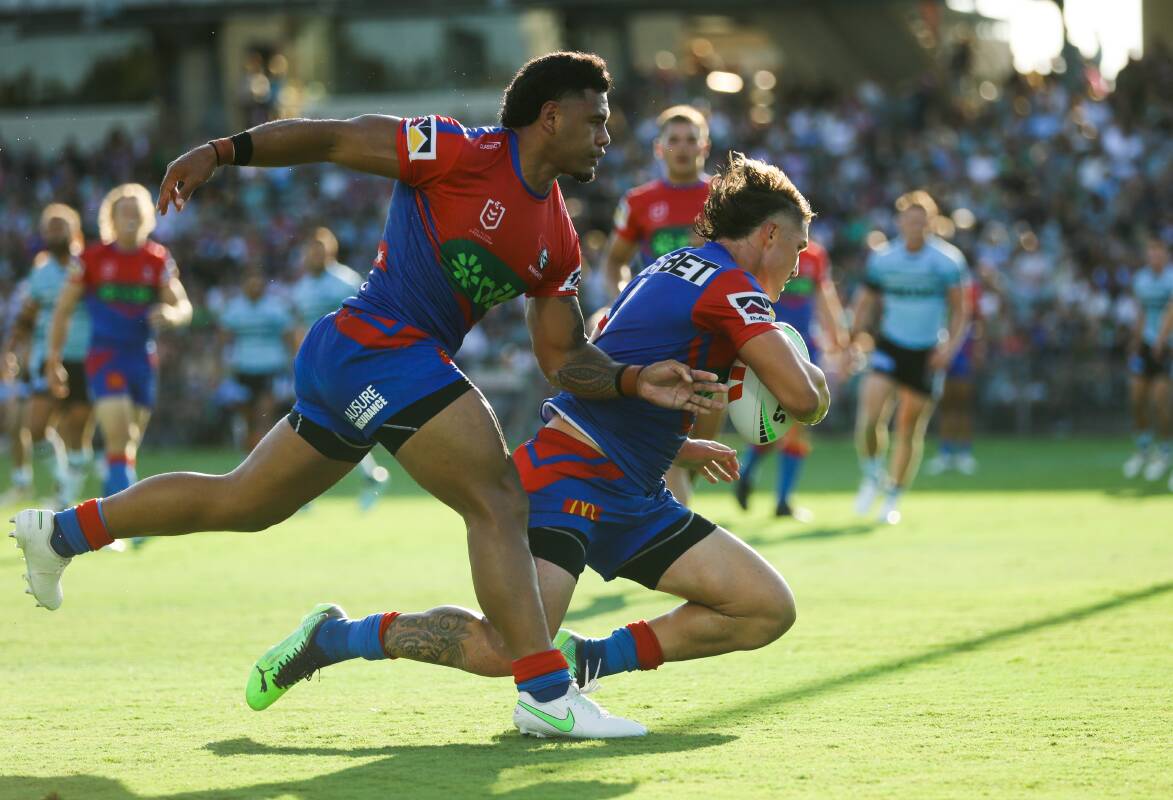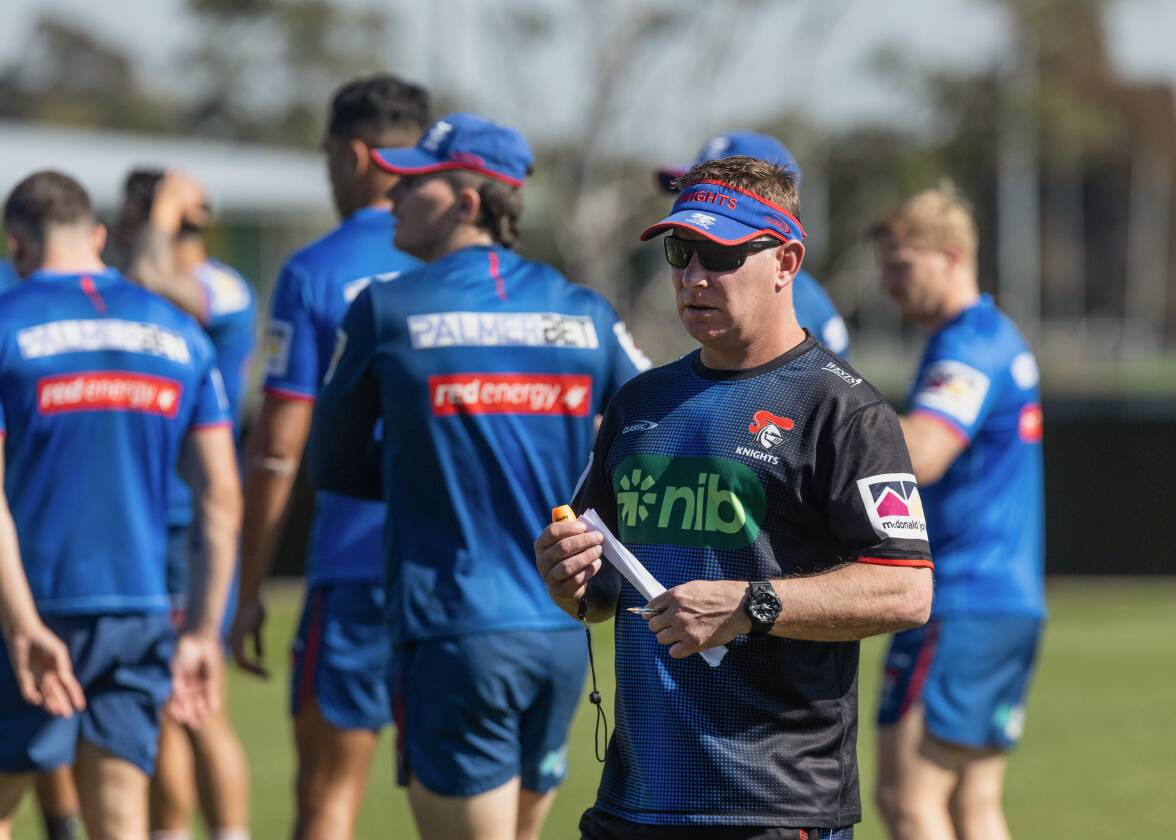
There is no luck associated with pickle juice. It's not a rabbit's foot. You only see it in moments of distress in sporting matches - when a player's leg muscle seizes in a cramp and he goes down, becomes immobile and clearly in painful distress. That's when a trainer on the field gives him a bottle of the juice from which he swigs that magically makes the cramp disappear.
It's got a funny name and almost everybody associates it with a home-made product you wouldn't drink unless you were trying to win a silly bet or prove you could drink anything.
Nine's rugby league commentators Andrew Johns and Phil Gould love making fun of it when they see it on the field.
So it is a really a magic elixir?
THE PICKLE JUICE STORY
The pickle juice phenomena started in the US, triggered by an American football game between the Dallas Cowboys and Philadelphia Eagles in 2000 on a day when on-field temperatures reached nearly 40 degrees. The Eagles handled the conditions much better than Dallas, aided by pickle juice. A couple of entrepreneurs watching the game decided to invest in making the juice commercially, and the rest is history.

It was only in 2015 that refined version of the product hit the market - Pickle Juice is a 100 per cent natural, purpose built isotonic sports drink. It has a vinegar base mixed with triple filtered water and contains no sugar, no caffeine and has added vitamins C and E plus zinc, potassium and sodium. The ingredients are dual filtered water, organic vinegar, salt, organic dill oil, potassium, zinc, Vitamin C, Vitamin E.
The product is in common use in professional and amateur sports clubs around the world. The Newcastle Knights buy their pickle juice from My Sports Tape, their official sports medical equipment supplier.
To be clear, the product works for most athletes as an immediate remedy to a cramping event.
Newcastle Knights high performance manager Matthew Jay came to club in late November of 2022, coming directly after completing his duties with the New Zealand national rugby league team which made the semi-finals of the Rugby League World Cup in the UK.
Jay worked for the Cronulla Sharks for 11 years and then had a year at the West Tigers.
In his book, the less cramps on a rugby league team, the better.

"Pickle juice is not the cornerstone to preventing cramp," he says. "It is a quick fix during a cramping moment, and it can be used, I use it in a subsequent preventative strategy for guys that are susceptible to cramp."
As he explains, "It turns the cramp off, or reduces the duration of the cramp. That's what the pickle juice does, through the acidic, vinegary taste of it.
"I couldn't tell you the underlying deep physiology under there. All I know is what's in the pickle juice, the vinegar taste of it, does something within the oral receptors of the mouth which sends the message to the brain and spinal cord, that 'hey, you're ok'. The muscle will calm down, stop cramping and reduce the duration of that cramp."

Within 30 seconds of consumption of pickle juice (trainers usually carry a 75ml bottle on to the field), the cramp dissipates.
There are other products that attempt to do the same thing. One of them is HotShot, a proprietary blend of ginger, cinnamon and capsaicin that can trigger the sensory nerves located in the mouth and esophagus, sending sending a calming signal to the hyperactive nerves that cause cramps and soreness.
The Knights don't use HotShot.
"Obviously, cramping occurs when the muscle is in a shortened state, so it's contracting," Jay says. "You see trainers stretching the muscle... putting the muscle in a lengthened state will help reduce the cramping, along with the pickle juice."
But to put the use of pickle juice in perspective, cramping is but one a myriad of issues that affects a player's performance, and a team's performance on the field in a game.
"It's one tool in the tool box to mitigate one thing that may reduce performance," Jay says of pickle juice. "If someone is cramping on an edge, and the opposition comes to that edge and that player can't move effectively, it could lead to a try. Anything that we can do to minimise weakness in our defence and our offence we certainly are going to do."
It's not a stretch to say a well-prepared team will use very little pickle juice.
"I'm a strong believer if you get your preparation right, you won't require it, unless someone is a seasoned cramper," Jay says. "And then, you'd probably have different strategies, that's within a game."
THE SYSTEM
Knights head coach Adam O'Brien and his players have repeatedly referred to keeping to "the system" as part of the reason for their winning streak of nine games in a row that they are carrying into the finals. It certainly refers to a team strategy of how they plan and play the game.

But their physical preparation from the day they hit the training paddock in late 2022 is also part of that system.
Taking the simple question of how does the club manage cramping, Jay's explanations provide a peek at how the club's own sports science strategy is designed for maximum performance - and victory.
"Firstly, hydration status is a factor, probably not as big a factor as people would think, but it contributes to cramping," Jay says. "Fluid intake in and around the game period, fluid intake during the game. Are you hydrating with electrolytes, which is vitally important, which is essentially just salt, and understanding that a dehydrated muscle can't do its job as efficiently as a hydrated muscle.
"So we keep our players adequately hydrated throughout the game to minimise cramp. You've got to look at sweat rates, some players have different sweat rates, some players have higher levels of sodium loss or electrolyte loss in sweat.
"You can have nutritional strategies for glycogen, glucose and carbohydrates. All of that. When you are eating, how much you are eating, what type of foods you are eating. I generally like to have a routine with players 96 hours into a game, and obviously post-game recovery. And those strategies we're putting into place, I guess, are to alleviate perceived effort of exertion.
"So obviously if you're hydrated and full of carbs, things can be a lot easier, but it will also reduce risk of cramp.
"One thing that probably doesn't get as much publicity is anxiety, and the cognitive demands of playing. If you're playing NRL for the first time, it could be a highly anxious moment for you. If you're an edge player and you've got to defend Nathan Cleary, that could be a highly cognitive demanding task for you, just because of the constant threat he is providing."
Lack of sleep, temperatures, rain - they can all contribute to cramping.
THE BIGGEST THING
"The biggest thing, from our perspective at the Knights, we've got to train them very hard," Jay says.
"We've got to expose them to demands that are greater than what the game is going to expose them to, so when we get into the game, we've been in those positions, and then, essentially, if we train the way we want to play we'll be ok in that regard because the game is easier than training."

A season of professional league is comparable to training for a mission. It is climbing Mt Everest as a team.
"Good training takes care of a lot of things," Jay says. "You get your training right, everything will work it out.
"You'll have good availability. You'll have players competing for positions. You'll have an intensity that is above and beyond the game at times - not the whole thing, obviously.
"And that's not just training on the field. That's training in the gym, your recovery strategies, education, all these educational moments for the players. If you educate them on how to prepare in the game and what their routine needs to be you can solve a lot of these problems as well."
Stress testing is part of that training.
"We put them in positions of stress at training so they can deal with the stresses in a game. We want them to be good stresses," he says.
"The perfect example is the Dragons game on the weekend. The Dragons had a really good period in the second half where they attacked our line and we defended our line and there was a high amount of stress put on the playing group - and a playing group that was not our common playing group because there was so many guys we were resting and young guys getting a go.
"But because of the stress or the pressure - pressure is probably a better word that stress - the pressure we put them under at training allowed them to execute the coaching game model regardless of what personnel were in the team.
"All of that has to go back to coaches."
KNOWING YOUR JOB
"Knowing what your job is can help reduce cramps. If I'm a player and I don't know how to be efficient with my movement in my positional group, I can work harder than I need to, which puts undue stress on me and those around me, which can increase risk of cramps. It's so dynamic and multi-factorial, you can't pinpoint it down to one thing.
"But, if everyone knows their job, if the game plan or game model the coach has put in place is understood by all, and everyone executes it, it probably should look like it's easy. I mean it's not, but it should. Because everyone knows their role, and everyone's doing their job, and they are conditioned to do that.
"When people don't know their role, don't know their job, and someone falls outside of the system, not from a footy perspective but just from a total energy and physiological perspective, that costs a lot more.
"When you move well and you move in unison you move as a team. You can actually conserve energy. You don't have to solve things on your own and that can reduce cramp. It's one of those things you can never put your finger on, but if you get the big rocks right, it will hopefully take care of itself."
Jay speaks from a wealth of experience in the arena of rugby league. The tenor of his voice is clear, the inner confidence about where the Newcastle Knights have taken themselves is evident. HIs explanation goes some way to explaining how a team that's been intentionally trained and shaped to compete as a unit can overcome teams that may be stronger or faster.
"It's staying in a system you are exposed to week-in week-out at training, and doing your job," he says. "You know... it's all extremely taxing, but we've got the training week right, we've got the preseason right, they can do it and repeatedly do it because everyone is working in unison.
"That 's one thing about the Knights players, they buy in and train hard. Regardless of outcome, you get the process right.
"The outcome often sorts it self out, which hopefully is going to occur in the next four weeks."
!["[T]he First and Fifth Amendments Require ICE to Provide Information About the Whereabouts of a Detained Person"](https://images.inkl.com/s3/publisher/cover/212/reason-cover.png?w=600)






